Best food in Italy: A foodie’s guide from North to South
Discover the best food in Italy in every region. From risotto in Milan to pizza in Naples, explore Italy’s authentic culinary delights from North to South.
Grab a coffee and settle in — it’s time to plan your journey through the best food in Italy. But first, check the clock. If it’s morning, a cappuccino is perfectly fine. After 12? Don’t even think about it. Italians reserve cappuccino — and all things frothed milk — for breakfast only. It’s all about digestion: milk is considered too heavy to consume after a meal.
Much like coffee, food in Italy follows its own delicious traditions. In this Italian travel guide, we’ll explore famous Italian food and authentic regional dishes, as well as where to try them, traveling from north to south.
1. Risotto alla Milanese: Milan, Lombardy
Golden and creamy with a subtle saffron aroma, risotto alla milanese is the pride of northern Italy. This iconic dish is a staple of Italian cuisine, often paired with osso buco for the ultimate comfort meal.
Wine pairing: Try it with a Franciacorta (Italy’s answer to Champagne) or a dry Lugana white from Lombardy—both complement the richness of the risotto without overpowering the saffron.
Dietary notes: Typically gluten-free, but check the broth used.
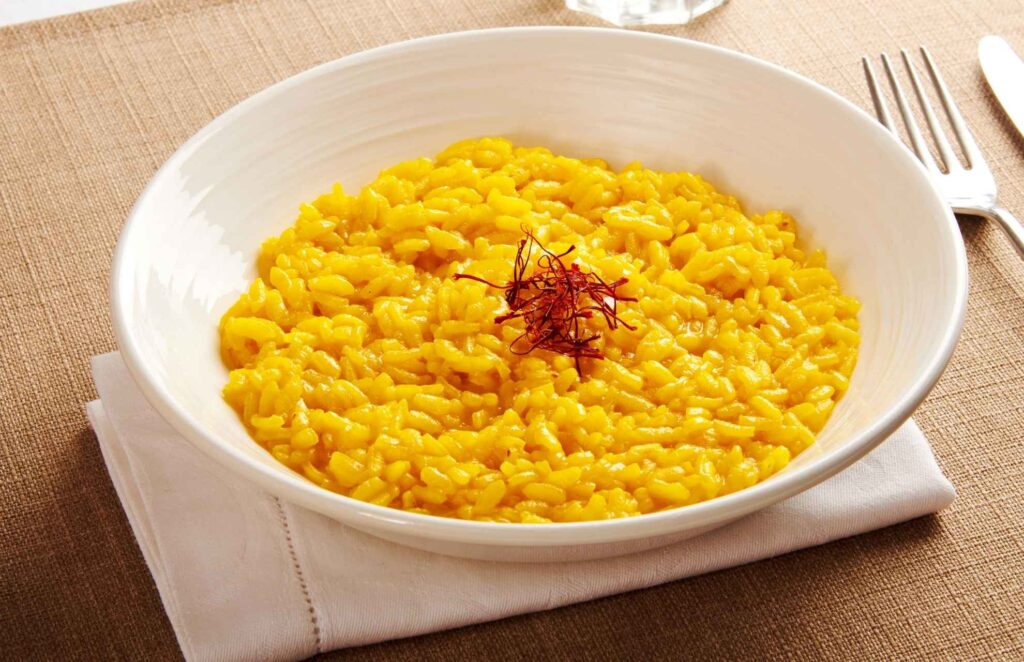
Where to try it:
- Trattoria Masuelli San Marco (Milan): A classic Milanese spot serving rich, perfectly cooked risotto with generous shavings of Parmesan cheese.
- Ratanà (Milan): A modern twist on traditional dishes in a beautiful setting, often cited among the best risottos in the city.
- Antica Trattoria della Pesa (Milan): Historic and cozy, ideal for a traditional risotto experience.
2. Osso buco: Milan, Lombardy
A Milanese classic, osso buco is a slow-braised veal shank cooked until tender, with the marrow-rich bone at its center. Served with gremolata and often paired with risotto alla Milanese, it’s one of northern Italy’s most comforting traditional dishes.
Wine pairing: Pair it with a Valtellina Superiore — a bold red from Lombardy made with Nebbiolo grapes that stands up beautifully to the richness of the meat.
Dietary notes: Contains meat and bone marrow; typically gluten-free if served without polenta or bread.
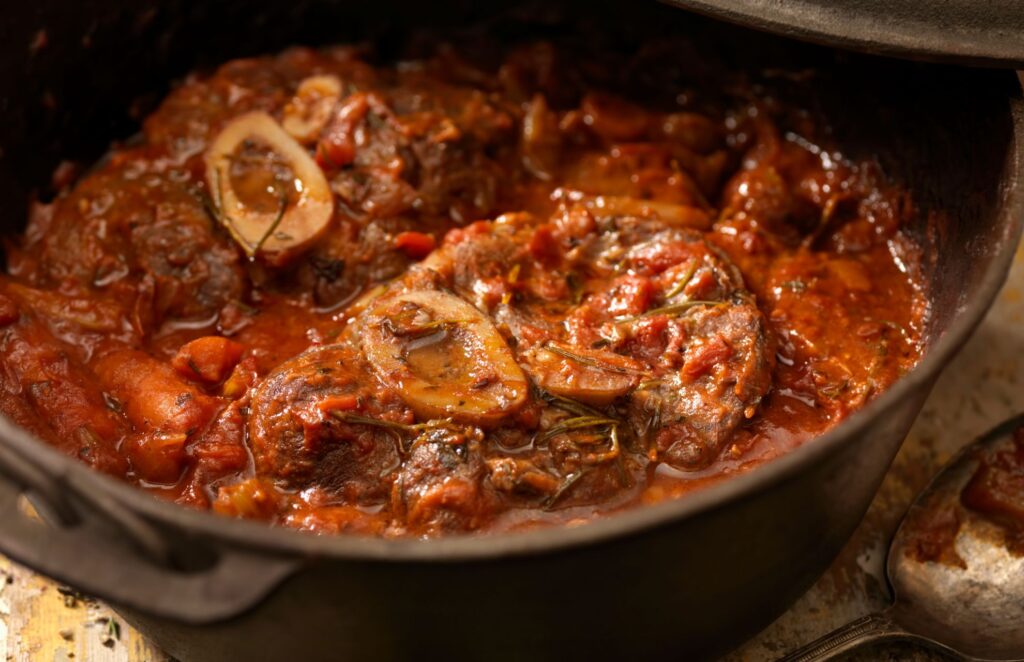
Where to try it:
- Al Matarel (Milan): A true old-school trattoria known for its traditional Italian cuisine, including tender osso buco.
- Trattoria del Nuovo Macello (Milan): Slightly modernized but respectful of the original flavors.
- Ristorante Il Solferino (Milan): Elegant, central, and loved by locals for its refined take on Milanese classics.
3. Florentine steak (Bistecca alla Fiorentina): Florence, Tuscany
Thick, juicy, and always grilled rare, bistecca alla fiorentina is a carnivore’s dream and a signature of Tuscan cuisine. Cut from the Chianina breed and weighing up to 1.5 kg, it’s typically served sliced and shared in Italian restaurants.
Wine pairing: A robust Chianti Classico — with its deep red fruit and earthy notes — is the perfect match for this bold, flavorful cut.
Dietary notes: Beef; always cooked rare unless specially requested and often served with potatoes or white beans.
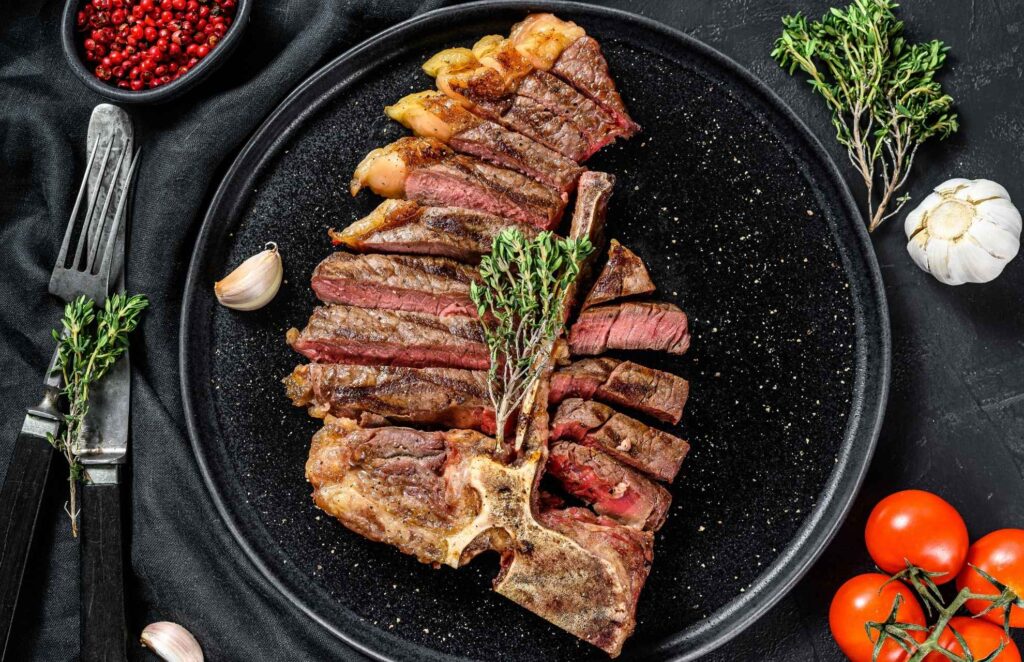
Where to try it:
- Trattoria Mario (Florence): Famous, no-frills, and fiercely loyal to tradition.
- Regina Bistecca (Florence): Upscale ambiance and top-quality cuts near the Duomo.
- Perseus (Florence): A local favorite for massive steaks and Tuscan classics.
4. Hearty Tuscan soup (Ribollita): Tuscany
Once a peasant staple, ribollita is now a beloved Tuscan comfort food. This thick, hearty soup is made with cannellini beans, day-old bread, seasonal vegetables like kale or cabbage, and a generous drizzle of Tuscan olive oil — slow-cooked to deepen the flavors.
Wine pairing: A rustic Rosso di Montalcino — earthy and medium-bodied — pairs beautifully with the soup’s humble, hearty ingredients.
Dietary notes: Vegetarian; often vegan unless finished with cheese. Naturally thickened with bread instead of cream.
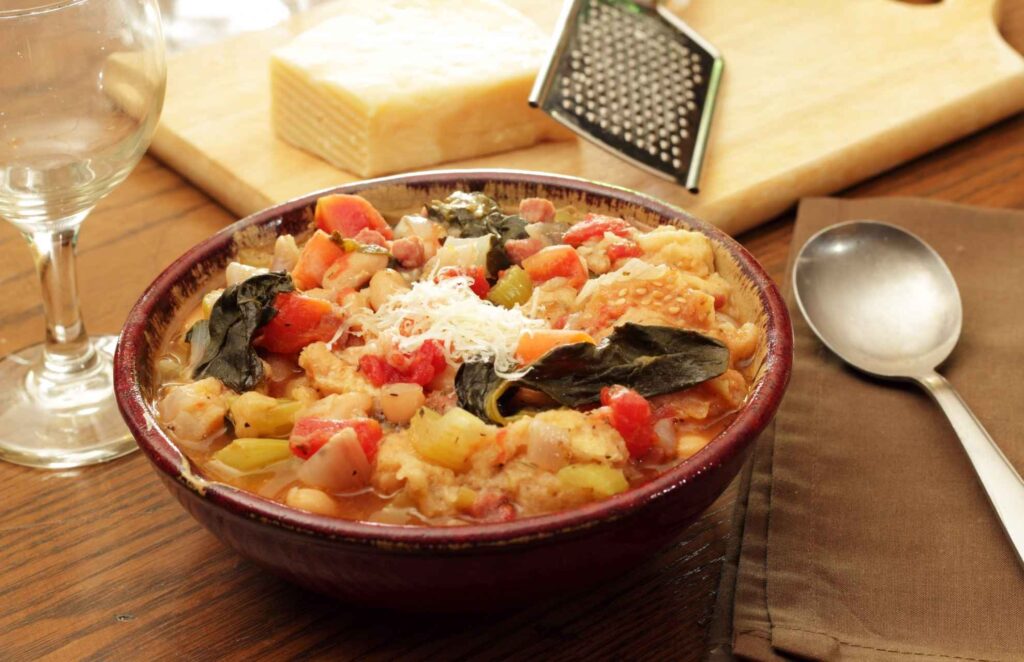
Where to try it:
- Trattoria da Burde (Florence): Time-tested recipes and rustic flavors in a traditional setting.
- Osteria Vini e Vecchi Sapori (Florence): A cozy gem serving authentic Tuscan classics.
- La Casalinga (Florence): Casual, family-run, and beloved by locals for its home-style cooking.
5. Tagliatelle al ragù: Bologna, Emilia-Romagna
Forget what you know about spaghetti Bolognese—the real deal is tagliatelle al ragù, a slow-simmered meat sauce served over fresh pasta. This rich, hearty, and deeply flavorful pasta dish topped with parmesan cheese is Italian cuisine at its most comforting.
Wine pairing: Try it with a glass of Sangiovese di Romagna — its bright acidity cuts through the richness of the Bolognese sauce.
Dietary notes: Bolognese sauce contains meat, and it is served with egg-based pasta and grated Parmigiano Reggiano. Contains gluten.
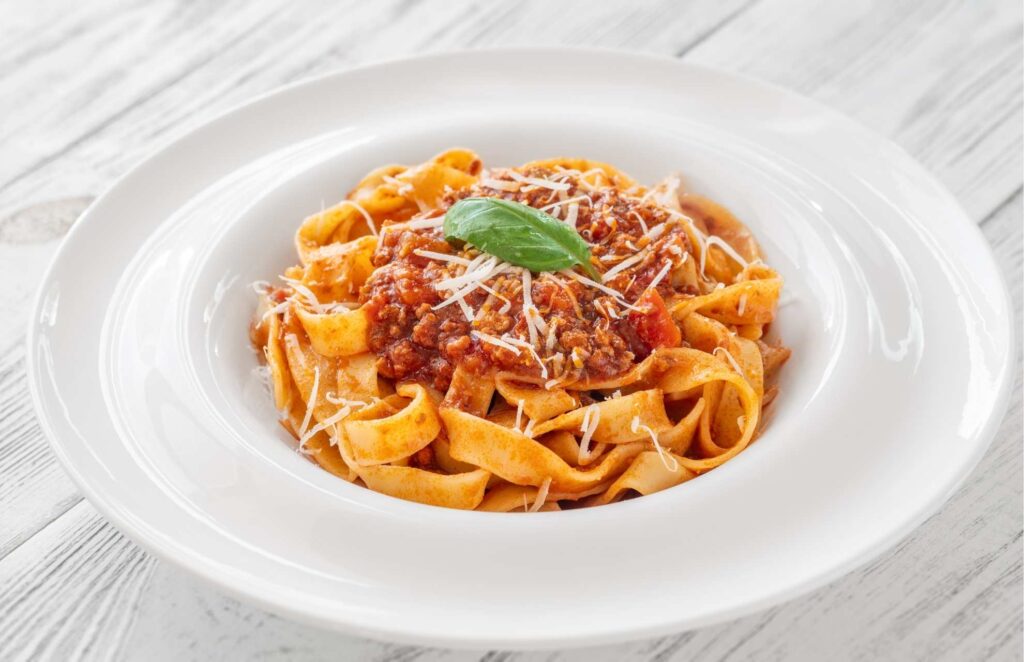
Where to try it:
- Trattoria Anna Maria (Bologna): Legendary for its handmade pasta and ragù alla bolognese.
- Trattoria da Vito (Bologna): A beloved spot frequented by iconic Italian musicians like Lucio Dalla and Francesco Guccini, it is known for its rich ragù alla bolognese.
- Trattoria Valerio (Bologna): Renowned for its warm, inviting atmosphere, Trattoria Valerio is the perfect place to experience this delicacy.
6. Cured meats and cheese (Tagliere Misto): Parma and Puglia
From Parma ham to mozzarella cheese, Italy’s love for cured meats and soft, creamy cheeses runs deep. A platter might include capocollo, speck, bresaola, and silky burrata — all drizzled with olive oil and paired with crusty bread and fresh basil. Whether served as an antipasto or a light lunch, it’s one of those Italian dishes that’s simple, satisfying, and deeply regional.
Wine pairing: A chilled Lambrusco — fizzy and slightly fruity — is the perfect match for salty cured meats and creamy cheese.
Dietary notes: Contains dairy and pork; typically gluten-free without bread.
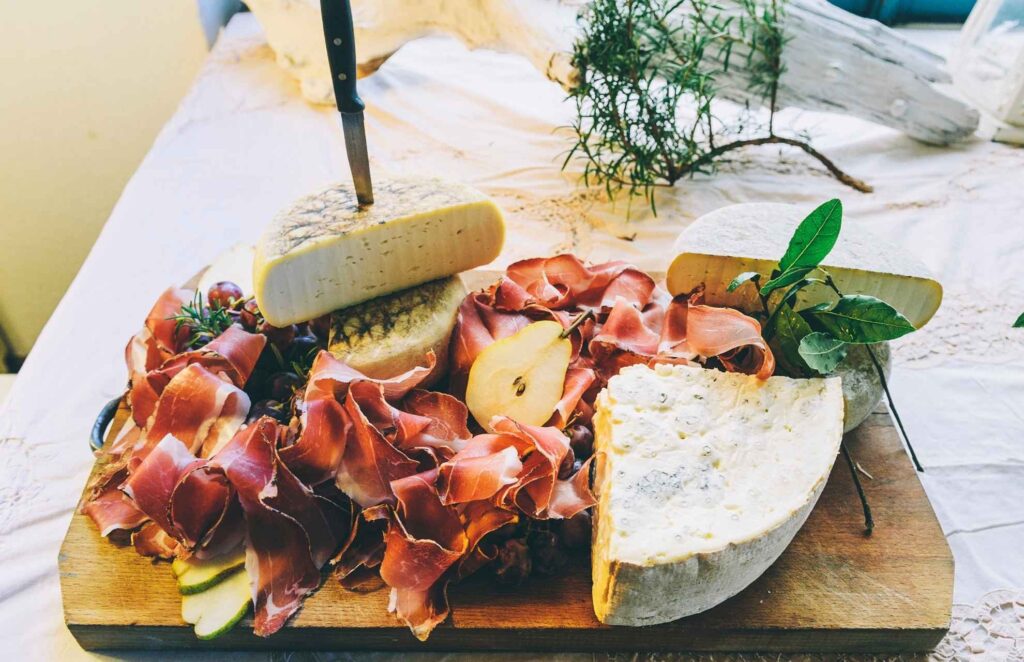
Where to try it:
- Salumeria Garibaldi (Parma): A deli-turned-icon known for top-quality Parma ham.
- Caseificio Voglia di Latte (Puglia): A farm shop where you can try burrata straight from the source.
- La Prosciutteria (Florence, Rome, Bologna): Laid-back, affordable, and overflowing with regional meat and cheese boards.
7. Pesto alla Genovese: Genoa, Liguria
This bright and full-flavored pesto is one of Italy’s most iconic sauces. Traditionally made with fresh basil leaves, pine nuts, extra virgin olive oil, garlic, Parmigiano Reggiano, and pecorino, it’s often tossed with trofie or trenette pasta in its home region of Liguria.
Wine pairing: A crisp Vermentino — light and aromatic — pairs beautifully with the herbal notes of pesto genovese.
Dietary notes: Typically vegetarian and gluten-free if served without pasta.
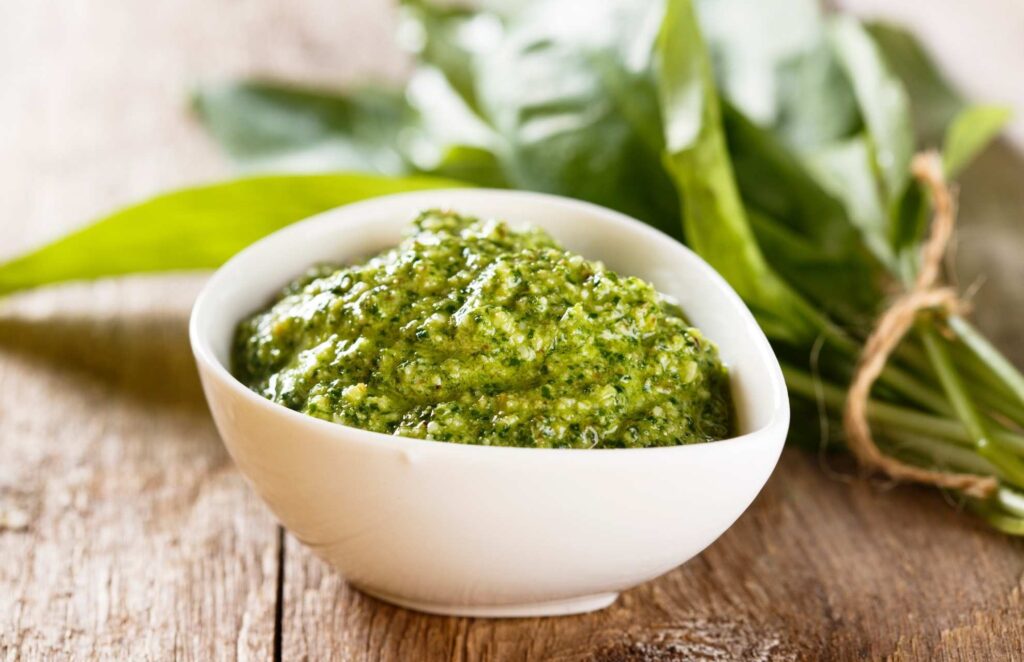
Where to try it:
- Trattoria Rosmarino (Genoa): Chic yet casual, with a modern twist on Ligurian staples.
- Il Genovese (Genoa): Famous for its authentic pesto made fresh daily.
- Osteria della Collina (Ligurian countryside): Off the beaten path, with housemade pasta and views to match.
8. Tiramisu: Veneto
Layered with coffee-soaked ladyfingers, whipped creamy ricotta or mascarpone, and dusted with cocoa powder, tiramisu is Italy’s most beloved dessert. Born in the Veneto region, it’s a staple of Italian cuisine and a sweet finish to any meal.
Wine pairing: A Vin Santo — sweet and nutty — complements the bitterness of the espresso and the richness of the cream.
Dietary notes: Contains dairy, eggs, and sometimes alcohol. Usually not gluten-free due to ladyfingers.

Where to try it:
- I Tre Mercanti (Venice): Known for its rotating selection of gourmet tiramisu flavors.
- Le Beccherie (Treviso): The birthplace of tiramisu — simple, classic, and legendary.
- Antico Forno (Venice): A rustic bakery offering indulgent slices of tiramisu alongside traditional pastries.
9. Sweet and sour sardines (Sarde in saor): Venice, Veneto
A staple of Venetian regional dishes, sarde in saor is a centuries-old antipasto of fried sardines marinated in onions, vinegar, pine nuts, and raisins. It strikes a perfect balance between sweet and tangy — a bold reflection of Venetian flavor. While you’re exploring the lagoon, try a crispy cone of fritto misto di mare (mixed fried seafood) for another taste of the coast.
Wine pairing: A glass of Soave — crisp, dry, and citrusy — brings out the delicate acidity of the marinade.
Dietary notes: Contains fish and nuts; often gluten-free if not breaded.
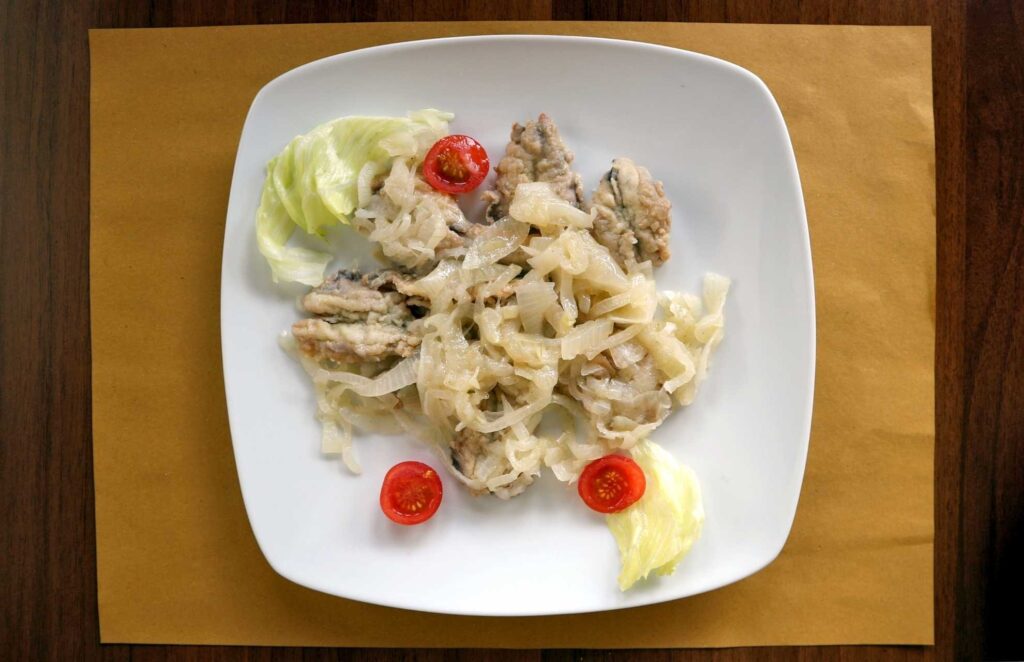
Where to try it:
- Trattoria da Bepi (Venice): Traditional and unfussy, known for its authentic take on sarde in saor.
- Osteria alle Testiere (Venice): Tiny but elegant, with an exceptional seafood menu.
- Cantina Do Spade (Venice): A lively bacaro (wine bar) serving small plates of local favorites.
10. Cacio e pepe: Rome, Lazio
Simple but brilliant, cacio e pepe is a Roman classic pasta dish made with just three ingredients: pasta, black pepper, and Pecorino Romano (with added Parmigiano Reggiano). It’s creamy without cream — a true showcase of balance and technique in Italian cuisine.
Wine pairing: A glass of Frascati Superiore — a dry white from Lazio — cuts through the richness while complementing the sharp cheese and pepper.
Dietary notes: Vegetarian; contains dairy and gluten. Best eaten fresh and hot.
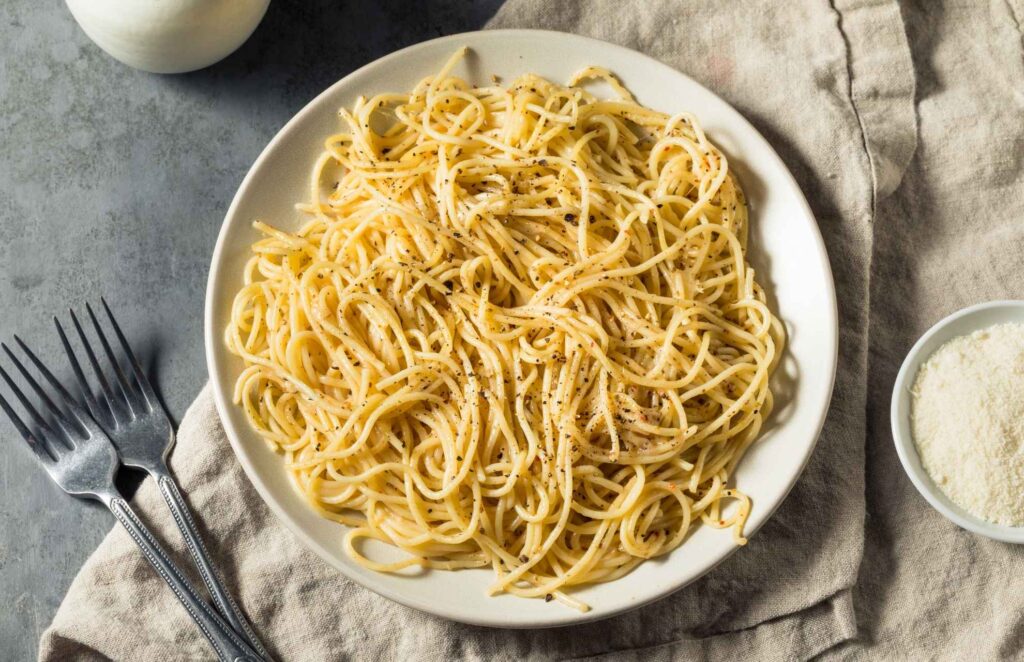
Where to try it:
- Felice a Testaccio (Rome): Legendary for its perfectly creamy cacio e pepe, mixed tableside.
- Trattoria Da Enzo al 29 (Rome): Beloved by locals, especially for this Roman pasta dish.
- Roscioli Salumeria con Cucina (Rome): A deli-meets-restaurant with a decadent, peppery twist on the classic.
11. Carbonara: Rome, Lazio
No cream, no nonsense — the real carbonara is a rich Roman pasta dish made with egg yolks, guanciale, black pepper, and a mix of Pecorino Romano and Parmigiano Reggiano. Silky and satisfying, it’s one of the most famous dishes in Italy, beloved for its bold flavors and status as a true example of authentic Italian food. It’s also one of Rome’s most craveable savory dishes.
Wine pairing: A Cesanese del Piglio — Lazio’s native red — offers just enough tannin and spice to match the dish’s bold, salty richness.
Dietary notes: Contains eggs, pork, dairy, and gluten. Best enjoyed fresh and never reheated.
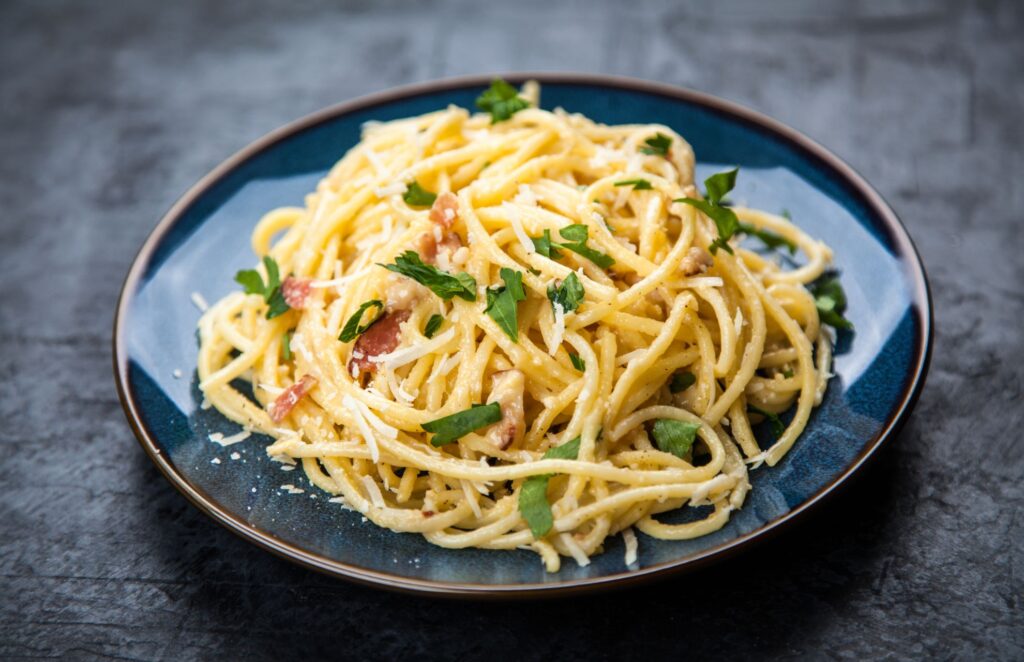
Where to try it:
- Roscioli Salumeria con Cucina (Rome): Yes, again — their carbonara is just as iconic as their cacio e pepe.
- Tonnarello (Rome): Bustling Trastevere spot serving up hearty portions and great atmosphere.
- Osteria degli Amici (Rome): Cozy, reliable, and a favorite for a perfectly balanced carbonara.
12. Pizza Napoletana: Naples, Campania
Pizza is what Italy is known for. Soft, blistered crust, San Marzano tomato sauce, melted mozzarella cheese, and fresh basil — pizza Napoletana is more than a meal; it’s a protected tradition. Pizza Margherita is actually a type of pizza Napoletana, made with a simple yet perfect combination of tomato sauce, mozzarella cheese, fresh basil, and a drizzle of extra virgin olive oil.
Wine pairing: A chilled glass of Lacryma Christi del Vesuvio — light, fruity, and made on the volcanic slopes near Naples — lets the ingredients shine.
Dietary notes: Vegetarian; contains gluten and dairy. Authentic versions use buffalo mozzarella (mozzarella di bufala).
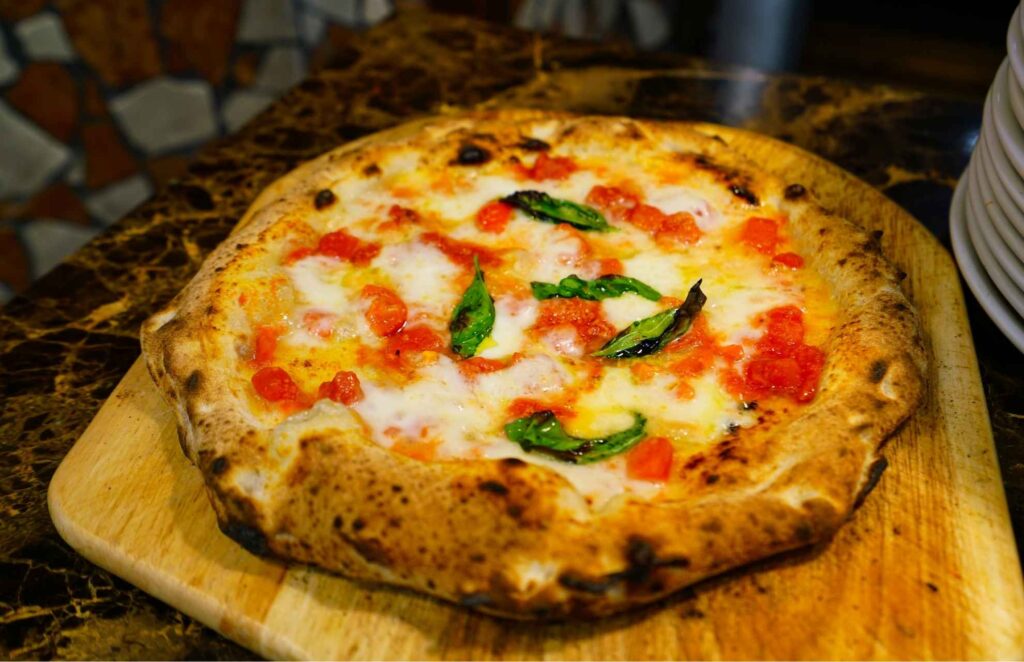
Where to try it:
- L’Antica Pizzeria Da Michele (Naples): The holy grail of Neapolitan pizza — and yes, the line is worth the amazing food they serve.
- Sorbillo (Naples): Famous, flavorful, and fiercely proud of their heritage — a true spot to eat pizza.
- Di Matteo (Naples): Beloved by locals for crispy edges and generous toppings on this famous pizza.
13. Spaghetti alle vongole: Naples, Campania
Simple, briny, and elegant, spaghetti alle vongole is an Italian seaside favorite made with fresh clams, garlic, parsley, and a splash of white wine. Finished with high-quality olive oil, it’s the kind of fresh seafood dish that tastes like a sea breeze on a plate — light but deeply flavorful.
Wine pairing: A chilled Falanghina — crisp and citrusy — brings out the best in the clams without overpowering them.
Dietary notes: Contains shellfish and gluten; usually dairy-free.

Where to try it:
- Trattoria Da Nennella (Naples): Casual, chaotic, and full of flavor — a must for popular food like this.
- Ristorante Ciro a Mergellina (Naples): Waterfront dining with classic takes on Neapolitan seafood.
- Da Dora (Naples): A little pricier, but beloved for its fresh clams and perfect seasoning.
14. Pasta alla Norma: Catania, Sicily
This Sicilian favorite combines sautéed eggplant, rich cherry tomatoes, and a topping of salted creamy ricotta (ricotta salata). It’s a perfect example of traditional dishes that are both simple and soul-satisfying — a tribute to Catania’s bold flavors and local pride.
Wine pairing: A glass of Etna Rosso — earthy and mineral-rich — matches beautifully with the dish’s roasted vegetables and tomato base.
Dietary notes: Vegetarian; contains dairy and gluten.
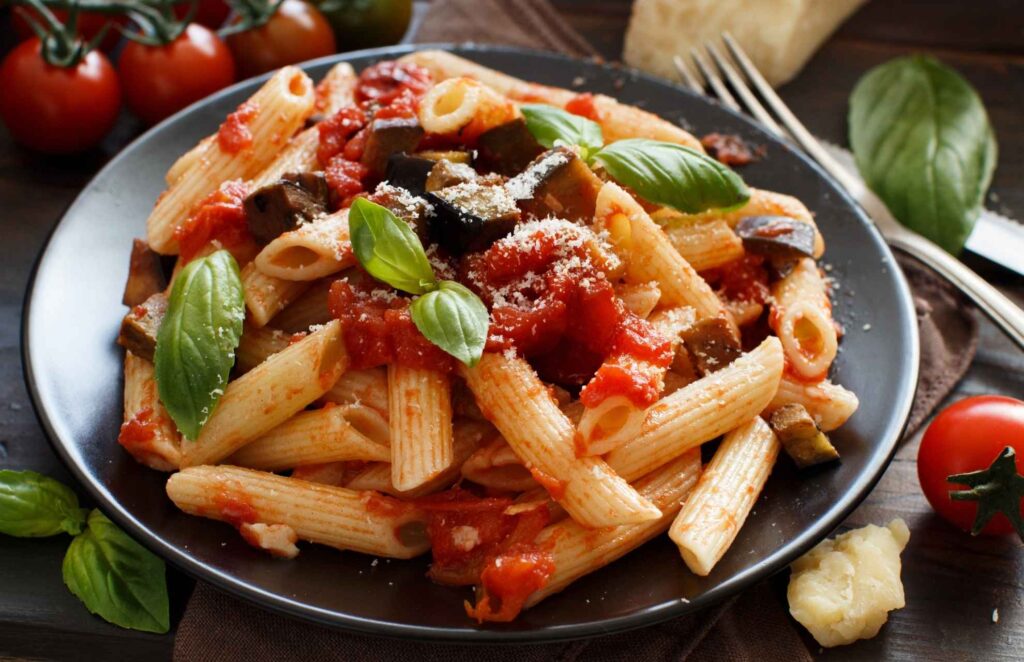
Where to try it:
- Trattoria da Antonio (Catania): Home-style, flavorful, and full of Sicilian charm.
Osteria Antica Marina (Catania): Located in the fish market, known for elevated local classics. - Al Gatto Blu (Catania): A quiet spot popular with locals and praised for its traditional preparation.
15. Arancine: Palermo, Sicily
Arancine (or arancini, depending on who you ask) are golden, crispy rice balls stuffed with ragù, peas, and mozzarella — a beloved street food in Sicily and one of the most iconic savory dishes of the island. The name means “little oranges” due to their shape and color, and they’re a must-try when wandering the streets of Palermo.
Fun fact: Sicilians argue over the correct pronunciation, with those from Palermo calling them arancine (feminine) and those from Catania opting for arancini (masculine).
Dietary notes: Contains dairy and gluten; often served with ragu alla bolognese filling but vegetarian versions are available.
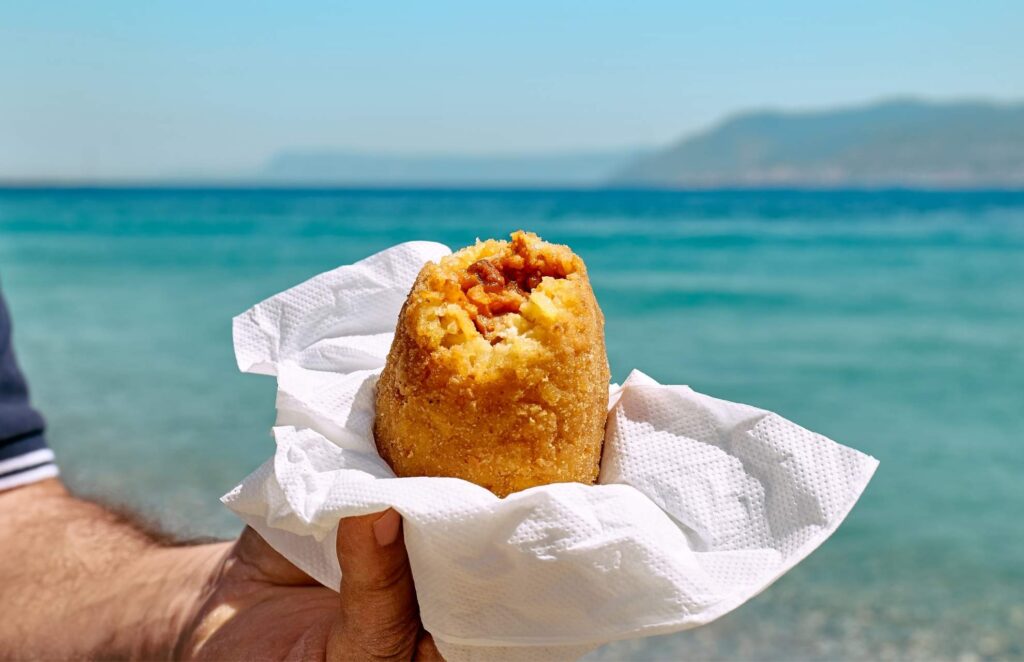
Where to try it:
- Antica Focacceria San Francesco (Palermo): Famous for its traditional arancine and Sicilian street food.
- Pasticceria Cappello (Palermo): Known for both sweet and savory arancine variations.
- Focacceria Basile (Palermo): A family-run spot serving up crisp, flavorful arancine with a local twist.
16. Panino con la milza: Palermo, Sicily
For the adventurous eater, panino con la milza is a famous dish in Italy that’s truly a hidden gem. This street food features a sandwich stuffed with tender, slow-cooked spleen and often paired with authentic Italian dishes like cheese, herbs, and a squeeze of lemon. Served on soft bread, it’s a must-try for those wanting to experience Palermo’s gritty charm and bold flavors.
Dietary notes: Contains offal and gluten; usually not vegetarian.
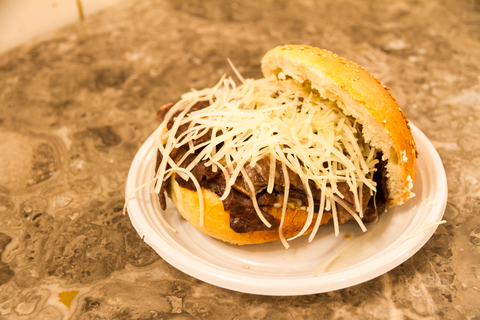
Where to try it:
- Antica Focacceria San Francesco (Palermo): Famous for its traditional take on authentic Italian dishes.
Focacceria Basile (Palermo): Known for its rich, flavorful panino con la milza, a staple of local street food. - I Sapori di Sicilia (Palermo): A casual stop where you can savor Palermo’s iconic street foods.
17. Gelato: Nationwide
Italy’s iconic gelato is far richer and creamier than the ice cream you know, made with more milk and less air. From chocolate to pistachio and everything in between, it’s one of the most beloved dishes in Italy. Whether enjoyed on a warm Rome evening or after a meal at the Amalfi Coast, gelato is the perfect sweet treat.
Gelato is not something you’d normally pair with wine, but it goes well with a delicious coffee or even lemon-flavored liqueur (Limoncello)
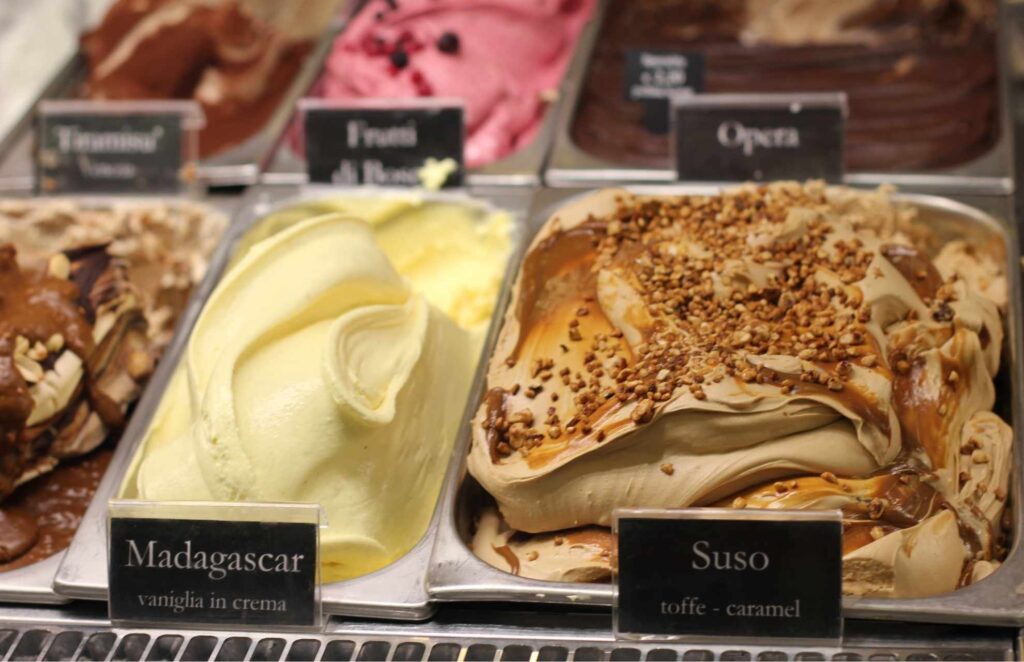
Dietary notes: Often dairy-based; vegan options available in some shops.
Where to try it:
- Giolitti (Rome): Legendary and famous for its creamy, artisanal gelato.
- Gelateria La Carraia (Florence): A local favorite for rich, creative flavors.
- Venchi (Milan): Offering a luxurious selection, from classic to innovative gelato.
Honorable mention: Artichokes
Carciofi (artichokes) are a hidden gem in Italian cuisine, especially when they’re in season during the winter and spring months. Whether deep-fried (alla giudia) in the Jewish Ghetto or braised (alla romana) with garlic, mint, and oil, these artichokes are a true regional dish that showcases Rome’s unique flavors.
Wine pairing: Pair with a crisp Frascati — its light acidity and minerality balance the richness of the fried or braised artichokes.
Dietary notes: Typically vegetarian, but be mindful of oil content for health-conscious diners.
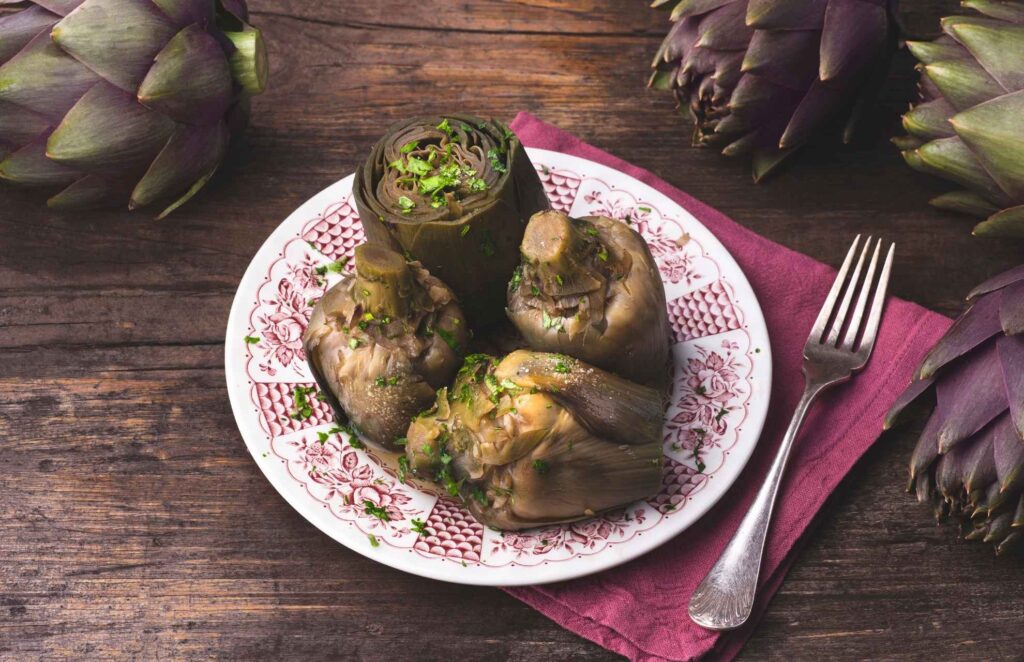
Where to try it:
- Nonna Betta (Rome): A famous spot for carciofi alla giudia, crisped to perfection.
- Da Enzo al 29 (Rome): A cozy Roman trattoria offering both braised and fried artichokes in a charming setting.
- Giggetto al Portico d’Ottavia (Rome): Known for their authentic Italian dishes and commitment to traditional Jewish Roman recipes.
Best Italian food by region
To help you plan your foodie journey through Italy, here’s a quick guide to the best food and each region’s favorite dish from North to South. From the creamy risottos of the North to the street foods of Sicily, these are the dishes you don’t want to miss when you visit Italy.
| Region | Signature dish |
|---|---|
| Lombardy | Risotto alla Milanese, Osso buco |
| Tuscany | Florentine steak, Ribollita |
| Emilia-Romagna | Tagliatelle al ragù, Cured meats and cheeses |
| Liguria | Pesto alla Genovese |
| Veneto | Tiramisu, Sarde in saor, Fritto misto di mare |
| Lazio | Cacio e pepe, Carbonara |
| Campania | Pizza Napoletana (Margherita), Spaghetti alle vongole |
| Sicily | Pasta alla Norma, Arancine/i, Panino con la milza |
| Nationwide | Gelato |
The final course: Tips for an authentic Italian experience
Embarking on a food journey through Italy is about more than just tasting delicious dishes — it’s about immersing yourself in the food culture of each region. Here are a few tips for your trip to Italy:
- Be brave and taste first, judge later: Some dishes might look unusual to untrained taste buds, but don’t be fooled. Embrace the regional specialties — they have a way of surprising you with flavors you never expected.
- Venture beyond touristy spots: Many of the best meals are served in family-run trattorias, offering their own specialties. Don’t hesitate to ask your hotel concierge for recommendations — they’ll point you to the authentic spots where locals eat that are not always in the city center.
- Take your time: Italian meals often last hours. Unlike in some places where you’re expected to finish quickly, no one will frown here if your meal stretches much longer than an hour. Savor every bite, as it’s all part of the authentic Italian dining experience.
- Let the seasons guide you: Italy’s cuisine changes with the seasons. Try frittura di pesce in the summer on the Amalfi Coast or enjoy hearty ribollita in Tuscany during the colder months to truly experience the local flavors at their peak.
- Stay connected: Relying on public WiFi isn’t always the best idea, especially in busy tourist spots. Your best option is choosing the best eSIM for Italy, ideally with unlimited data. That will allow you to navigate the alleyways of Italian cities, bookmark the best food spots, and share your culinary adventures on the go.
Holafly’s eSIM for Italy provides unlimited data for a set number of days, making it ideal for travelers who want to avoid roaming in Italy and stay connected. To make this a perfect trip through Italy, you need your phone, a Holafly eSIM, and a great appetite.





 Language
Language 


















 No results found
No results found





